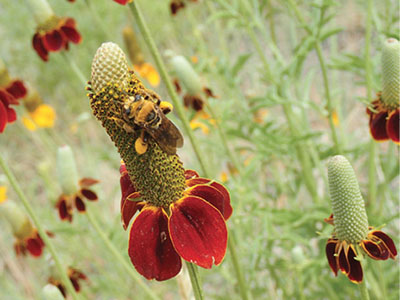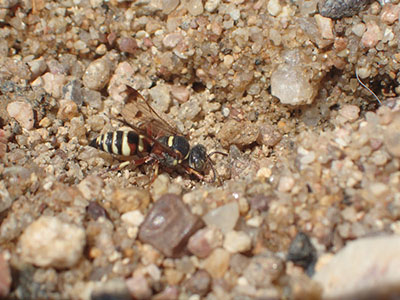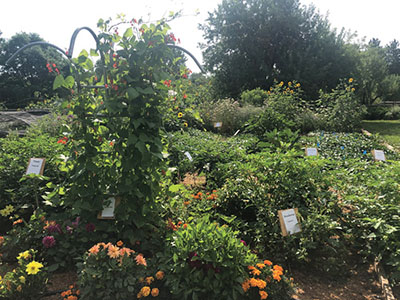Guide H-181
Miranda L. Kersten, Melissa A. Schreiner, and Amanda Skidmore
College of Agricultural, Consumer and Environmental Sciences, New Mexico State University
Authors: Respectively, Program Manager, Agricultural Science Center at Los Lunas; former Research Assistant, Agricultural Science Center at Los Lunas; and former IPM Small Farm Specialist, Department of Extension Plant Sciences, New Mexico State University. (Print Friendly PDF)
Introduction
Beneficial insects, including bees, wasps, butterflies, moths, flies, and beetles, provide important ecosystem services, such as pollination and natural pest control, in gardens and agricultural systems. Over 80% of fruits, vegetables, and native plants rely on pollinators to produce fruits and seeds (Ollerton et al., 2011). In addition to being vital for plants, pollinators are considered a keystone species group (many species rely upon them for survival) and indicator species (the health of their populations can give a view into ecosystem health). Unfortunately, many pollinators are in decline because of habitat loss and fragmentation (habitat is divided into smaller sections), pathogens and parasites, pesticide use, pollution, and climate change (Potts et al., 2010).
Encouraging Pollinators and Beneficial Insects
In the urban landscape, home gardeners and farmers can help wild pollinator populations by providing habitat and selecting management practices that promote pollinators and other beneficial insects. While specific habitat requirements vary by species, all pollinators need food, shelter, and water.
Plant a diversity of flowers, and include flowers that bloom in different seasons. Lepidopteran pollinators (butterflies and moths) need host plants for their larval (caterpillar) stage; however, some caterpillars may also be considered pests. Consider planting extra plants to allow for some feeding by caterpillars, and also consider your own threshold for feeding damage. On small farms, areas with flowering non-crop plants or cover crops can help to increase ecosystem services provided by beneficial insects (Carrié et al., 2012).
Pollinators also need a place to call home. This can include bare ground for ground-nesting bees, dried stems or logs for stem-nesting bees, and protected places for butterfly chrysalides. Pollinators have evolved with native plants, which are best adapted to the local growing season, climate, and soils. Planting native plants can invite native beneficial insects to the garden or farm, such as pollinators, seed dispersers, and decomposers (Figure 1). Many native plants are perennial and will come back year after year to provide floral resources. Habitat in home gardens and small farms can greatly assist beneficial insects; however, land and pest management decisions can adversely impact beneficial insect populations (Mata et al., 2017). For example, management practices that frequently disrupt the soil, such as tilling, may discourage ground-nesting bees from nesting in an area, or may impact existing populations in addition to disturbing other beneficial soil fauna (Sivakoff et al., 2018).
Figure 1. Perennial plants, like prairie coneflower (Ratibida columnifera), attract pollinators and other beneficial insects to your garden (photo by Melissa A. Schreiner).
Integrated Pest Management (IPM)
Integrated pest management (IPM) combines cultural, mechanical/physical, biological, and chemical control strategies. It puts an emphasis on preventing pest issues and using chemical alternatives to reduce chemical use when pest issues do occur. By practicing IPM, you can help to promote pollinator habitat in gardens and small farms. IPM is not a one-size-fits-all form of management, and IPM strategies should be tailored to the target pest while also considering your farm/garden and surrounding habitat. Financial savings, chemical reduction, and environmental benefits can be a result of focusing treatments on target pests. To learn more about implementing IPM practices, see NMSU Extension Circular 655, Integrated Pest Management (IPM) for Home Gardeners (https://pubs.nmsu.edu/_circulars/CR655/).
Chemical control involves the application of pesticides, whether conventional or organic, to plants, soil, and other surfaces to control pests, including weeds, insects, fungi, and diseases. Pesticides have the potential to negatively impact pollinators in different ways. Insecticides can directly kill pollinators. Herbicides can reduce the abundance and diversity of the flowering plants that pollinators rely on. Early lab studies show that glyphosate, a broad-spectrum herbicide, may impact microorganisms that live in the honey bee gut, leaving honey bees more susceptible to disease (Motta et al., 2018). Fungicides can indirectly affect bee health and can result in death. Often times, the effects of pesticides on native bees are unknown and may be more harmful to solitary bees than honey bees, which pesticides are tested on. Additionally, the effects of adjuvants (substances added to the pesticide formulation) and the impacts of tank mixes (combining one or more pesticides in solution) on insects are often unknown. Organic pesticides can also impact pollinators and beneficial insects, so be sure to research before using any pesticides, whether conventional or organic. To learn more about using organic insecticides, see NMSU Extension Guide H-168, Selection and Use of Insecticides for Organic Production (https://pubs.nmsu.edu/_h/H168/).
It is important to note that “do-it-yourself” and “homemade” pesticides, such as dish soap and vinegar, are usually ineffective and have a high risk of causing negative impacts on pollinators and their habitat, as well as pet and human health. We do not recommend the use of these products, and they should not be considered a “safer” or less-toxic option for pollinators.
Pollinators forage across the landscape and do not recognize human-defined boundaries, so a large-scale landscape approach should be considered for pollinator management. Building a balanced garden by providing pollinators access to diverse plants and habitats should be a part of your IPM program. Consider all suitable IPM practices for controlling pests. Use practices that discourage pest infestations, and carefully diagnose your pest problems early on. Determine the need for treatment through pest scouting or monitoring. Table 1 lists different actions that can be taken in your IPM plan.
|
Table 1. Suggested IPM Practices to Protect and Encourage Pollinators in Small Farms and Gardens* |
||
|
Practices |
Gardens |
Small Farms |
|
Prevention and Planning: Plan in advance to reduce future problems. |
|
|
|
Monitoring: Document and identify pests accurately. |
|
|
|
Cultural: Manipulate the landscape to make it more suitable for pollinators and less suitable for pests. |
|
|
|
Mechanical/Physical: Directly remove or reduce pests, or create a protective barrier between plants and insects. |
|
|
|
Biological: Introduce natural enemies into the system (augmentative biocontrol) or enhance habitat for beneficial insects (conservation biocontrol) to suppress pest populations. |
|
|
|
Chemical (organic and conventional): Avoid or limit chemical use, including herbicides, fungicides, and insecticides. If chemical interventions are deemed necessary (i.e., action threshold is reached), follow these practices. |
|
|
|
*This table lists suggested management practices for gardens and small farms to protect and encourage pollinator populations in your landscape. Practices in each column may be suitable for both gardens and small farms. Choosing the best practices for the pests that are actually present is key. Some methods may not be appropriate for all situations. |
||
Figure 2. Solitary vespid wasps act as pollinators and predators and nest in bare ground (photo by Melissa A. Schreiner).
Figure 3. Planting several types of crops and plants (polyculture) can help to mimic natural ecosystems and provide habitat for beneficial insects (photo by Melissa A. Schreiner).
Other NMSU Extension Resources
- For more information on New Mexico’s native bees, see Pocket Guide to the Native Bees of New Mexico (https://pubs.nmsu.edu/bees/).
- For recommended annual plants for conservation biological control, see NMSU Extension Guide H-169, Using Insectary Plants to Attract and Sustain Beneficial Insects for Biological Pest Control (https://pubs.nmsu.edu/_h/H169/).
- To learn more about beneficial insects, see Pocket Guide to Beneficial Insects of New Mexico (https://pubs.nmsu.edu/insects/), and NMSU Extension Guide H-172, Backyard Beneficial Insects of New Mexico (https://pubs.nmsu.edu/_h/H172/).
References
Carrié, R.J.G., D.R. George, and F.L. Wäckers. 2012. Selection of floral resources to optimise conservation of agriculturally-functional insect groups. Journal of Insect Conservation, 16, 635–640.
Mata, L., C.G. Threlfall, N.S.G. Williams, A.K. Hahs, M. Malipatil, N.E. Stork, and S.J. Livesley. 2017. Conserving herbivorous and predatory insects in urban green spaces. Scientific Reports, 7, 1–12.
Motta, E.V.S., K. Raymann, and N.A. Moran. 2018. Glyphosate perturbs the gut microbiota of honey bees. Proceedings of the National Academy of Sciences, 115, 10305–10310.
Ollerton, J., R. Winfree, and S. Tarrant. 2011. How many flowering plants are pollinated by animals? Oikos, 120, 321–326.
Potts, S.G., J.C. Biesmeijer, C. Kremen, P. Neumann, O. Schweiger, and W.E. Kunin. 2010. Global pollinator declines: Trends, impacts and drivers. Trends in Ecology and Evolution, 25, 345–353.
Sivakoff, F.S., S.P. Prajzner, and M.M. Gardiner. 2018. Unique bee communities within vacant lots and urban farms result from variation in surrounding urbanization intensity. Sustainability (Switzerland), 10.
For Further Reading
CR-655: Integrated Pest Management (IPM) for Home Gardeners
https://pubs.nmsu.edu/_circulars/CR655/
H-168: Selection and Use of Insecticides for Organic Production
https://pubs.nmsu.edu/_h/H168/
H-172: Backyard Beneficial Insects of New Mexico
https://pubs.nmsu.edu/_h/H172/
Miranda Kersten is a Program Manager with the urban integrated pest management (IPM) program at NMSU’s Agricultural Science Center in Los Lunas. Her work focuses on pollinator and beneficial insect conservation, monitoring beneficial insects across urban landscapes, and managing IPM research projects.
To find more resources for your business, home, or family, visit the College of Agricultural, Consumer and Environmental Sciences on the World Wide Web at pubs.nmsu.edu.
Contents of publications may be freely reproduced, with an appropriate citation, for educational purposes. All other rights reserved. For permission to use publications for other purposes, contact pubs@nmsu.edu or the authors listed on the publication.
New Mexico State University is an equal opportunity/affirmative action employer and educator. NMSU and the U.S. Department of Agriculture cooperating.
August 2022 Las Cruces, NM






